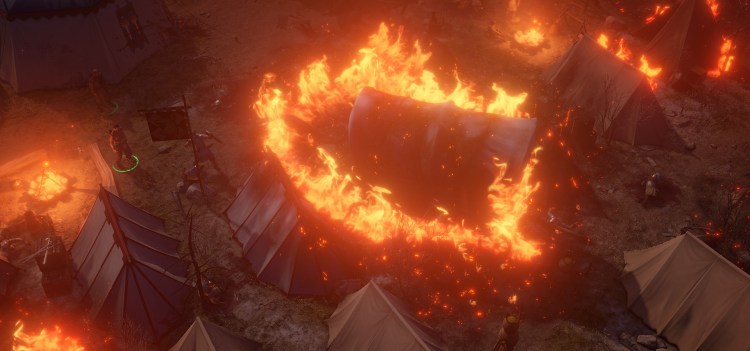Whenever I think of adapting tabletop role-playing campaigns to a PC game, my mind goes to Temple of Elemental Evil. It’s one of the seminal modules of Dungeons & Dragons, and in 2003, Troika Games released a near 1-to-1 conversion of it as a PC game.
And boy, did it have problems beyond bugs despite having all the bones of a fantastic RPG and being one of the best adaptations of the tabletop rules.
It’s faithful, but because of this, it lacks the guiding hand of a Dungeon Master to help with the flow and to give the characters and encounters inside this digital Greyhawk any sense of depth and emotion. Over the years, a group of modders fixed a number of problems, and thanks to their work, it’s a much better game, if a little clunky.
Owlcat Games attempted a similar feat with Pathfinder: Kingmaker, and it had a similar issue at launch — it missed the guiding hand of the Game Master (I also find it interesting that they share similar gameplay systems, as ToEE uses D&D‘s 3.5 ruleset, and Pathfinder is a branch of those very same rules). But over a series of patches and other improvements, Owlcat whipped Kingmaker into good shape.
June 5th: The AI Audit in NYC
Join us next week in NYC to engage with top executive leaders, delving into strategies for auditing AI models to ensure fairness, optimal performance, and ethical compliance across diverse organizations. Secure your attendance for this exclusive invite-only event.
And in December, Owlcat announced its second game — Pathfinder: Wrath of the Righteous. It’s an adaptation of Pathfinder publisher Paizo’s adventure path of the same name, and last month, I interviewed creative director Alexander Mishulin and longtime RPG writer Chris Avellone about adapting it. In our long-ranging discussion, we talked about how you work material from the existing narrative, sprinkle in your own creations, and make it all work in a satisfying computer game experience.
This is an edited transcript of our interview.
GamesBeat: These are established adventure paths that have already been written. As a writer, what can you do with this when adapting the narrative as a video game?
Chris Avellone: Obviously, Paizo turned out the adventure paths, and Kingmaker was very well-received as a storyline. We wanted to make sure we were upholding that story. But at the same time, we want to tell stories, too. We want the players to be able to have an interactive experience. For Kingmaker, the additional storylines were introduced, one, with the number of companions in the party. Those weren’t part of the adventure path at all. They each have their own character arcs throughout the game. Owlcat was also really good about introducing stuff that they wanted to include. One thing I liked about working with the team was that they had played Kingmaker many times with their homebrew [tabletop] campaigns, so they had a lot of stuff in their campaigns that they wanted to put into the computer game. “Oh, here’s how we can develop Kingmaker based on the tabletop sessions we had.” Wrath of the Righteous is much the same way.
We have the companion arcs coming in as well. There are narrative elements that Owlcat wants to add. And then also there is a new element that the adventure path has, where they introduce this thing called Mythic Paths. Not only can you advance your character up in levels, whatever character class you are, but then also you can gain mythic powers as well, like a Hercules path. “Hey, I’m the hero of the gods.” You get new narrative information based on that, new abilities based on that. But each of those mythic paths have their own storyline associated, too.
So you have the companion stuff. You have the narrative elements that Owlcat and I are adding. Then also you have the Mythic Path storylines. There’s a lot more story going into that, too. There’s still a lot of work to be had.
GamesBeat: In a way, your role is that of a screenwriter. You’re adapting the material for a computer game.
Avellone: Yeah, it’s like if you had adapted half of a creation that was already made, and then also you’re like, “OK, but also there’s another 50% that we also just make up on our own.” That’s part of the process, too. Also, one challenge with the adventure paths as well is, tabletop sessions, when they do modules, sometimes we’ll have things like, “Here’s Jubilost. Here’s two paragraphs on him, and that’s his character. Here’s some stats.” But then when we put him in Kingmaker, for example, there’s a lot of work involved to make him a character with a schedule. Here’s a companion arc. Here’s what he’s doing in the game. There’s a lot of stuff to write, whereas a module can get by with two summary paragraphs. We have to flesh that out in a lot more detail.
GamesBeat: Is there going to be some of the stuff you homebrewed in your own campaigns, Alexander, that you’re bringing to the game?
Alexander Mishulin: Of course. We played Wrath of the Righteous on the table, each member of the team. This time around, we had six campaigns running simultaneously. The biggest thing for us, the changes we’re introducing to the adventure path, is that we’re allowing players to change alignment in this adventure. The initial material was strongly aligned toward good characters like Paladins and Clerics destroying the forces of evil. It doesn’t make sense for us to limit our players to just one type of alignment.
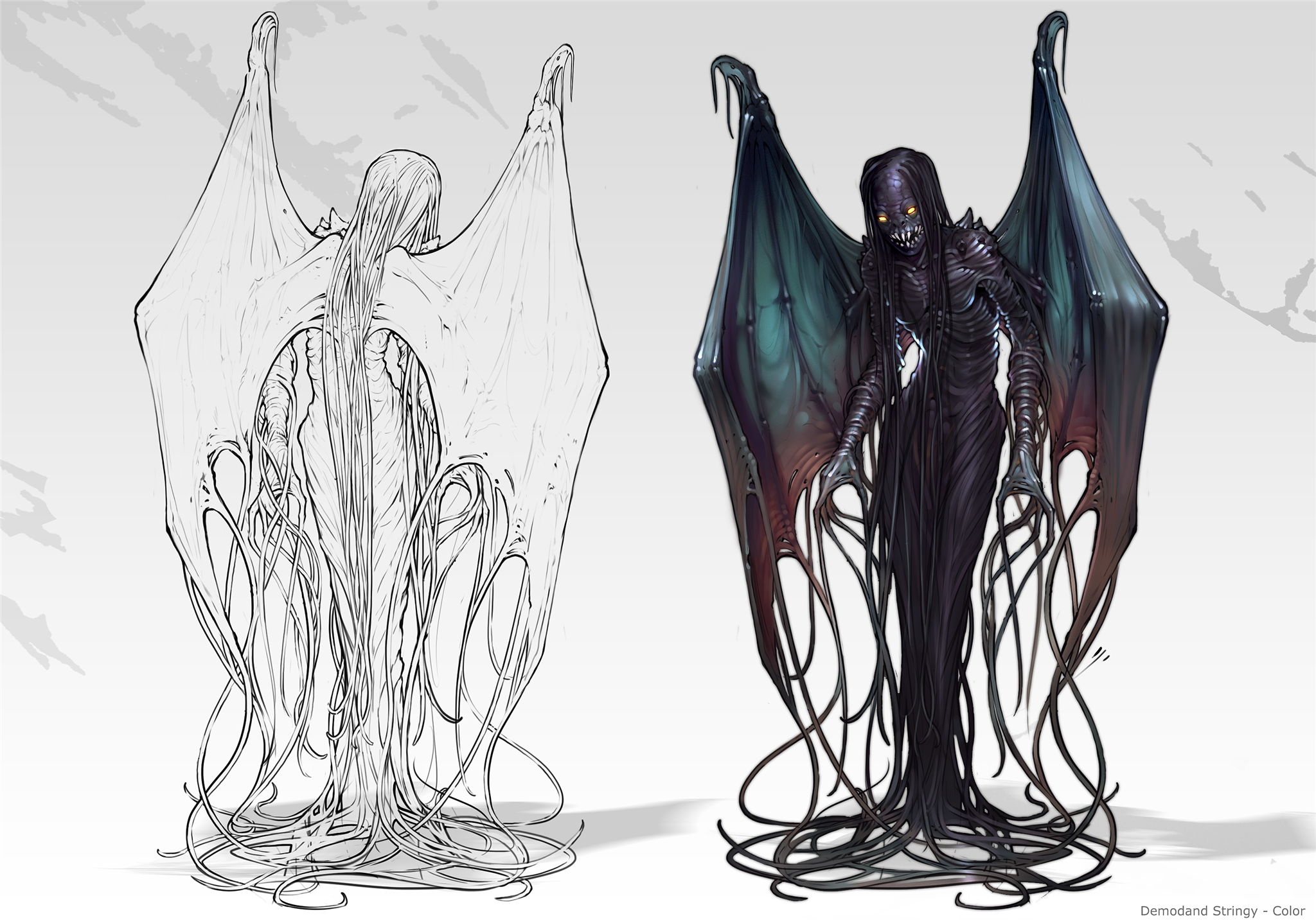
Above: The Stringy Demodand looks like it’s in a bad mood.
Avellone: [Alignment restrictions] limit role-playing. You’re not giving players a spectrum to interact with the story. You’re dictating, “Hey, here’s the only way to play, the only alignment you can choose.” You’re cutting off a segment of players. If I want to be chaotic neutral, or if I want to be true neutral and pursue a balance in the situation, that’s not something we want to deny players from role-playing. That would make me very sad, and make Alexander very sad.
GamesBeat: And with the Mythic Paths, you can become a lich. You can be evil and still fight demons?
Mishulin: Yes. With the story, why it happens that way, it’s still really close to the initial material, but with twists and turns. We allow for you to become a lich, or to befriend a hell knight, and do a lot with the hell knights. They have their own agenda around destroying the demons. For evil guys, the simplest option is, “I want this land for myself, and if I don’t fight the demons, the demons will have it, not me. I have to oppose that.”
Avellone: Devils and demons don’t get along very well. Also, I’ve always seen devils as like, they’re the lawyer evil aspects, and then the demons, which are the big Worldwound gods, Worldwound adversaries in this game. They’re more chaotic evil, where they just want to go around and slaughter everyone. The devils are more like, “So, once you sign the contract, I hope you read the fine print.” They don’t get along super-well.
GamesBeat: The scope of Kingmaker, it’s pretty big. I’m in my second playthrough, and I’m sure I’m still missing things. Is Wrath going to be a similar scope? Is the game going to be of a similar size?
Mishulin: It’s simultaneously yes and no. For Kingmaker, we were aiming at about 80 hours per playthrough, and we ended up with 120. It was too big, and some of our fans even wrote to us [asking us to] please make the experience a bit more contained. Right now, for Wrath of the Righteous, we’re also aiming at about 80 hours, but this time around, we’ve properly done all the tables and everything, and it seems like we’re going into smaller amounts of playtime. But on the other hand, because of the Mythics and more choices and more effects those choices have on the story, the game is wider. You’ll be, on your first playthrough, missing more content than in Kingmaker. There’s more replayability.
GamesBeat: Does that allow you, as a writer, Chris, to go deeper into the narrative by limiting the scope?
Avellone: Actually, for a writer, it presents — it’s more fun in the sense that you can tell — even though all players will experience every aspect of the story, like Alexander was saying, with the mythic paths, you can really dive deep into each one of those. Also, the idea that, oh, I wish I could have told this story — well, in Wrath, you can. It’s just that not every single player will see that story. The nice thing about that is that when you play it versus someone else, you can talk about it, and you’ll have markedly different experiences. I went down the lich path and this happened. What, you had an undead army? What? I went down the Aeon path, I was judging people left and right. You can talk about the differences in the playthrough, what was cool about it.
Baphomet’s scheming
Mishulin: We’re telling the story of the part of Golarion that was invaded by demons. We wanted to tell a more deep story about all of that, what it takes to withstand the demons for 100 years. Do people break? Do people get corrupted? Do they redeem themselves despite their initial attitude and actions? When you get a chance to fix the whole situation, how do you approach it? Do you rush into your goal and sacrifice human lives as you go? Or will you be trying to save everyone you possibly can? Do people become victims of the demons as you go? There are lots of different, more deep elements to the story and the choices and consequences.
GamesBeat: In many works that are derivative of D&D, demons are just the embodiment of chaos, and you see them more in destructive terms, but they don’t seem like they do so much about tempting and corrupting mortals. Will that be something that demons do in this game?
Avellone: Yes. The major adversaries, that’s kind of their sole focus. Even the demons don’t get along with each other, so even the principal architects of creating the Worldwound, they have differing viewpoints. Sometimes there’s even demons who are reluctantly involved in it, who don’t actually want to be part of it. You get to see those machinations as well. Also, they do things like manipulation of the player, attempt to corrupt NPCs. The crusade that you’re involved with in Wrath is like the Fifth Crusade, and what the demons have been trying to do with some of the crusades — the third especially — is they actually weren’t about conquering the lands around the Worldwound. They were about spiritually weakening everybody. They start burning witches at the stake who didn’t deserve to be tried and judged. Everyone starts getting paranoid and turning on each other. That was kind of their psychological assault on the lands around. We’re going to make this beautiful, fertile field to grow all this corruption as people turn on each other. Seeing those elements in the adventure path and being able to write for that has been really interesting.
Mishulin: It’s an adaptation of the existing adventure path, and we’ve talked about what we’re changing in things like the alignment of the player. This is a minotaur mini-boss. For minotaurs, who have a whole range of concepts, it’s probably eight different kinds of them, as it was with trolls in Kingmaker. In Wrath you’re fighting essentially Baphomet [a demon lord]. The minotaurs follow Baphomet. There are guys like this, guys with wings, half-fiend minotaurs. We did a pretty good job of making them powerful.
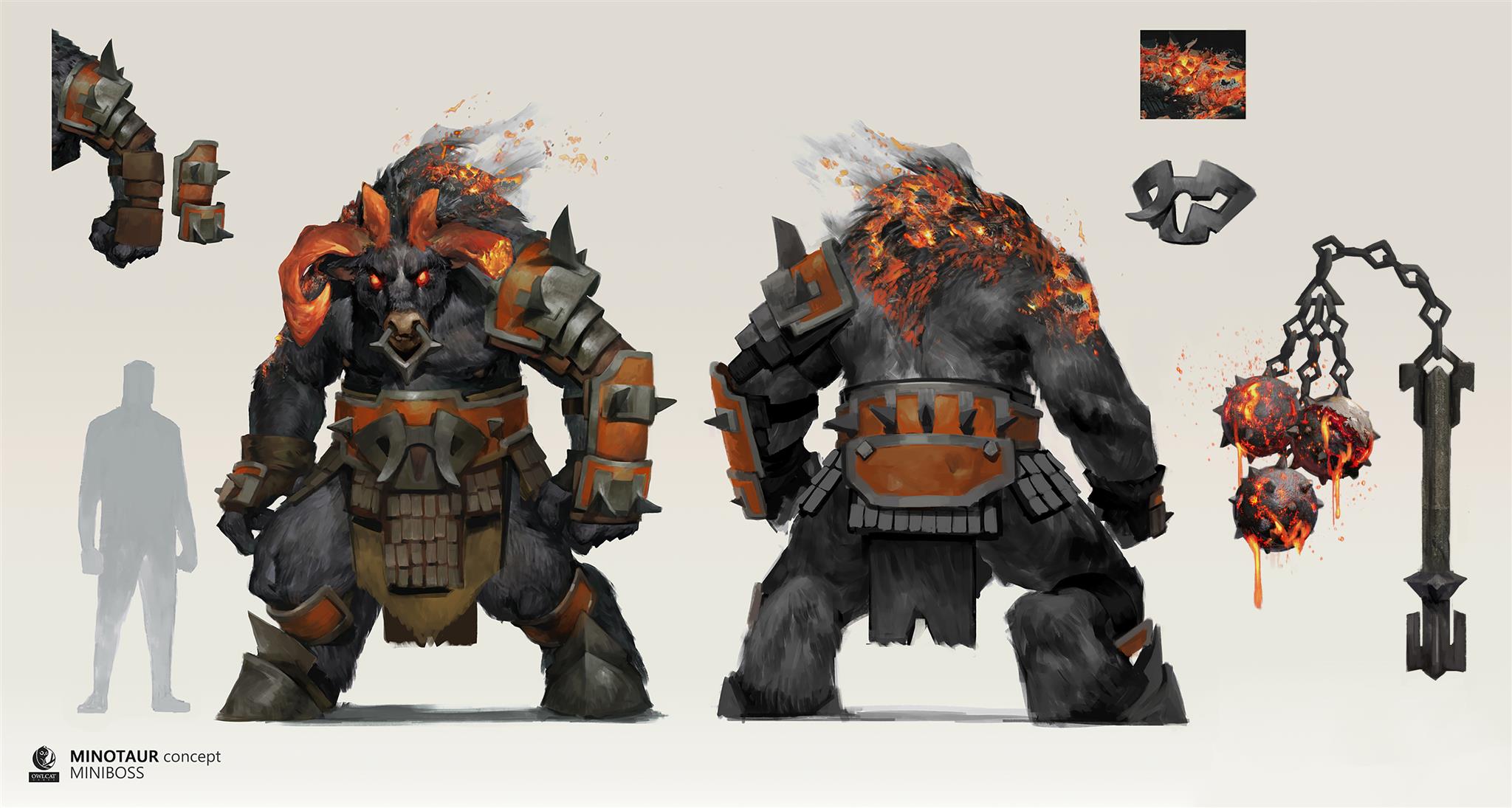
Above: Minotaurs are some of Baphomet’s favorite beings.
GamesBeat: Where does the tempting angle of demons come in with Baphomet? There’s not much tempting there. He’s more about sheer power.
Avellone: Yeah, that’s because he’s one of the principal demon lords, but you’re absolutely right. I think Baphomet is a good example of the devil-demon rivalry. What happened with Baphomet, if I understand correctly, Baphomet was always a demon lord. He was a major minotaur lord. I think he pissed off Asmodeus, the devil. He’s like, you think your minotaur can find your way out of the maze? Well, I’m going to make this incredible ivory labyrinth in my kingdom that you’ll never escape from. He puts Baphomet in there. Baphomet gets out of that maze in like 10 years, which is a lot shorter than being trapped there forever, and what’s worse is he takes that entire labyrinth that Asmodeus has constructed, and because he beat it, he moves that over to the Abyss, and that becomes his domain. So that’s caused some rivalries there because of that insult. But that’s an example of, that’s part of the conflict between devils and demons. Baphomet as a corrupter, granted that’s not his principal aim, but he’s only one of the cast of characters.
Mythic time
Mishulin: We announced four mythic paths so far: angel, lich, aeon, and trickster. We talked about three of those in the previous interview. The aeon is the one we didn’t talk about. Aeon is a cosmic judge for balance. It’s here to fix any imbalances that he finds. The interesting thing about the aeon, when he’s traveling the streets of his capital — eventually you’ll be getting to his capital — the aeon has the ability to see the auras of people who somehow affect the balance and need to be judged and punished. The aeon can approach them and start an investigation about what’s really happened and how to fix it.
GamesBeat: When it comes to balance, do they lean more to law than to chaos?
Mishulin: It could be any upsetting of the balance, law against chaos or good against evil. They want it to be perfectly balanced all around. Another cool thing about the aeon is that when there is a great disturbance in balance, the aeon can travel back in time and fix it. After that, his current timeline will be changed, usually for the better.
GamesBeat: How does time travel fit into the adventure path?
Mishulin: I can give just one example, because otherwise I’ll be spoiling a whole lot of story. There is a character that enhances the demons. You’ll meet this character, find out how the demons work with them, and eventually find a place where you can go back in time to fix this great imbalance. And in the process of fixing that, you make it so this person isn’t corrupted. He’s not enhancing the demons. He’s just a normal guy who will probably come to help you if you play your cards right. The great thing is that most of the demons you’ll start to encounter after you return to the current timeline are changed into normal ones. You’ll weaken them by doing so. There’s a whole small side story about this character, about his initial corruption.
GamesBeat: Chris, I’ve talked to so many writers who say that they hate dealing with time travel. Do you?
Avellone: I think it can be used improperly. I’ve seen a lot of movies and TV shows that have been taken over by time travel, because it wasn’t negated or controlled. That, along with cloning, are the two things, or the dark selves thing, I’d be really careful with those things. I don’t mind when it’s used with some very clear constraints, but I think it, otherwise, has the potential to really destroy a franchise.
GamesBeat: What are the challenges with writing about time travel?
Avellone: The first thing you want to do is ask why you’re doing it. There’s a clear reason why we want to do it here. The other thing is making sure that you’re able to telegraph … the player needs to see what the result of the time travel is. That sounds obvious, but if you never encountered one of those stronger demons before you went back in time and fixed it, and then came back, then the consequence wouldn’t mean anything to you. Oh, I guess these guys are weak here, but I never met the original version, so I don’t know how bad they are. Those are things you should keep in mind.
Mishulin: To get back to the Mythics a bit, this one is not in the demo. It’s from further down the road. It’s one of the lich abilities, about dealing damage and debuffing creatures. Because we can now rotate the camera, you can pause and rotate. This ability will be really powerful and visually interesting. The reason those creatures are not dying is because it’s a special occasion where our visual effects artists test those effects. In this particular video, there is no mechanical component attached to it, so the creatures aren’t really dying. But those outlines are debuffs. They’ll also take a lot of damage. Those creatures, apart from this one, will be dead.
GamesBeat: Is this death realm an ability or a spell?
Mishulin: For the lich it’s an ability. I don’t remember exactly if we talked about how the Mythic paths connect to the classes. The Mythic Path itself contains some of the abilities that you’ll have. As you can imagine, liches are connected to arcane and spellcasting. If you combine the lich with a wizard, the combination will be a more powerful spellcaster with more options and access to powerful spells, but if you combine lich with a fighter or somebody without arcane knowledge, those characters will start using arcane spells, specific ones that are available to the lich. It increases the diversity of the character.
GamesBeat: Can clerics or paladins become liches?
Mishulin: It depends. It’s kind of freaky, because to follow one of the Mythic Paths, you have to fulfill certain mission conditions. Some Mythic Paths should be unlocked when you play through the game. There will be some that are just presented to you, like an angel. You’ll know about that almost from the beginning of the game. There are other Mythic Paths, like trickster, that have to be unlocked and certain conditions have to be fulfilled. By fulfilling those conditions, most probably you’ll be doing actions that some characters find nasty or inappropriate. It could lead to you getting out of the alignment requirement for, say, paladin. You could try for it, but probably you’ll be a fallen paladin if you become a lich. It’s a nice story. Our current development stage, we’re on what we call second playable … the complete second chapter of the game, about 10 hours long. We got a lot of feedback from playtests, from our core community, and we took parts of the feedback and polished the latest maps for the second chapter to become a demo.
GamesBeat: The Worldwound keeps popping up. What is it, and what role does it play in this story?
Mishulin: I can’t answer about the role of the Worldwound, because that would be spoiling everything. But the Worldwound, it’s a bit difficult to answer, because there are things that characters know, and then things that the game master knows, because it was written for the game master. The characters in the game know that a powerful sorceress opened a portal. She was contained in Threshold. Threshold was a kind of prison for mages in Sarkoris. Somehow she opened a portal to the demons in the center of this prison. In this particular place in Golarion, the Abyss and Golarion itself are rather close. In past times there were invasions by demons and a desperate fight to go through the veil between this point. It was stopped by Aroden back in time. But now it’s just a huge gap, and the Abyss is mixing with Golarion. It allows demons easy entrance, and also it’s like a home territory, so you can’t banish them back to their original plane. They can exist here easily.
Avellone: It’s a huge abyssal gate. It’s on Golarion, and all the demons pour out of it. The terrain has changed around it, where all the abyssal crap is bleeding out into the landscape. You get new insects, new vegetation, new weather patterns, and it’s all awful. It’s a pretty dark stain on the surface of Golarion.
Mishulin: It has a crucial role in the whole storyline, but I can’t go further than this.
GamesBeat: And there’s no similar Hellsmouth?
Mishulin: There are some very contained gates to the Hells, related ones in Kenabres, but that’s in other stories. Hell’s Rebels and Hell’s Vengeance are a pair of adventure paths that tell the story of crushing the rebellion and you’re playing with evil guys, or inciting the rebellion and playing with good guys. It’s an interesting story for another campaign.
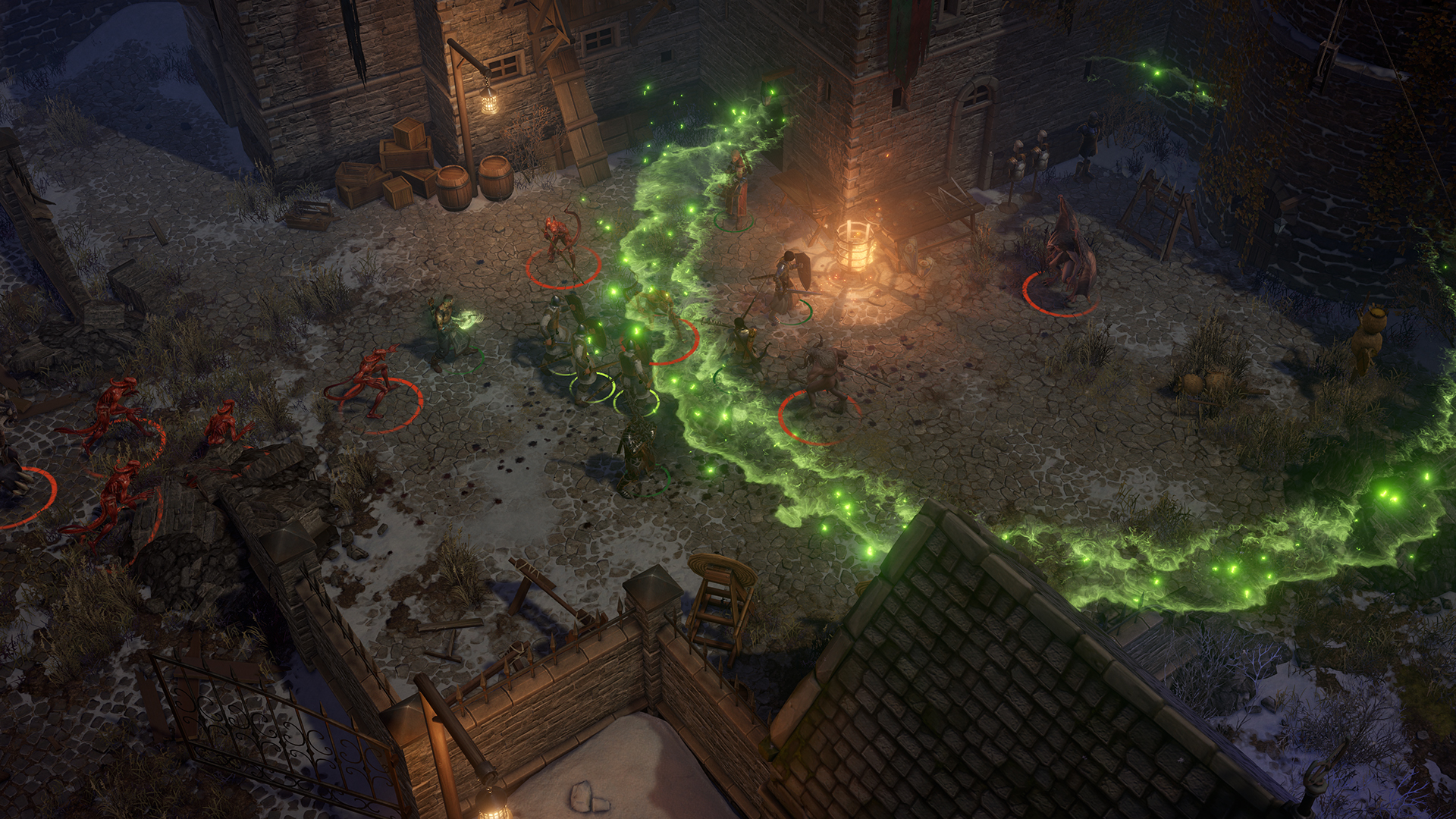
Above: Babau demons want to rend your flesh in Drezen.
GamesBeat: Is Kenabres another town the demons have taken over? Or are they trying to?
Mishulin: At the beginning of the adventure, the demons attack Kenabres. At the center of Kenabres is a wardstone … a part of the safeguarded network that paladins, clerics, with the help of Iomedae, the goddess herself, put to prevent demons from spreading into the whole of Golarion. The demons attack the city, attack this wardstone. I could tell the story further, but you survive the initial attack on the city with the crusades, with some Mythic Powers. The path isn’t chosen there. The path is chosen in the second chapter. But you save Kenabres.
After that you visit Queen Galfrey, and she promotes you to be lord commander of the Fifth Crusade. That means you’ll be commanding the Crusade. We really liked how that worked strategically in Kingmaker. Apart from the mechanics and all that stuff, it also allowed us to showcase our campaign and see a different perspective as you were governing, how she has programs for growing her nation.
GamesBeat: Is this an effort by one nation, or does Queen Galfrey have the authority with a bunch of nations to establish this?
Mishulin: It’s an effort of Mendev, because they’re nearby. But a lot of followers of Iomedae flock into there to fight the demons, because it’s a noble goal. It’s protecting the whole world. Also, some countries support Mendev financially, especially the neighboring ones, because they understand what will happen if Mendev falls and the demons just flow out of there.
Avellone: There’s at least one kingdom, sort of the jackass kingdom in Kingmaker. They made a mention in the source material that they saw the First Crusade as an opportunity to get rid of a lot of asshole mercenary companies. “Hey, you guys wanna go on a Crusade? Just get the fuck out of our country.”
Mishulin: But because these crusades have happened for the last hundred years, people get tired. Especially during the Fourth Crusade, morale was rather low. A lot of lowlifes got into the crusades to get food and clothing and somehow avoid the military action, just to get away from their lives. It’s become a kind of stalemate at the beginning of the adventure. These are gargoyles here. You’ll be commanding the crusade, and that means you’ll be making some governmental decisions, similar to Kingmaker. But you’ll also be able to recruit an army and send them out on the world map to battle the demons and reclaim parts of the world map, maybe find some powerful artifacts to bring to the party and make them stronger.
Sage advice
GamesBeat: Will your party have adviser roles again?
Mishulin: Yes. There will be advisers. The Crusade itself is still very much in development. For the nation-building, we had eight versions, prototype designs and everything. For the Crusade we hope that there will be less prototyping involved. [Laughs] Everything I will be telling you about the Crusade is subject to change, still under development. When we prototype it it could change drastically.
But the current idea is you’ll be sending those groups across the world map and reclaiming some lands and finding some artifacts. As for battles themselves, it’s not like we’re playing a Total War experience, because it would be too much for one game to include everything. We actually discussed it early in the project, and we could pull it off in the engine, but if we’re doing that, we’re not doing anything else.
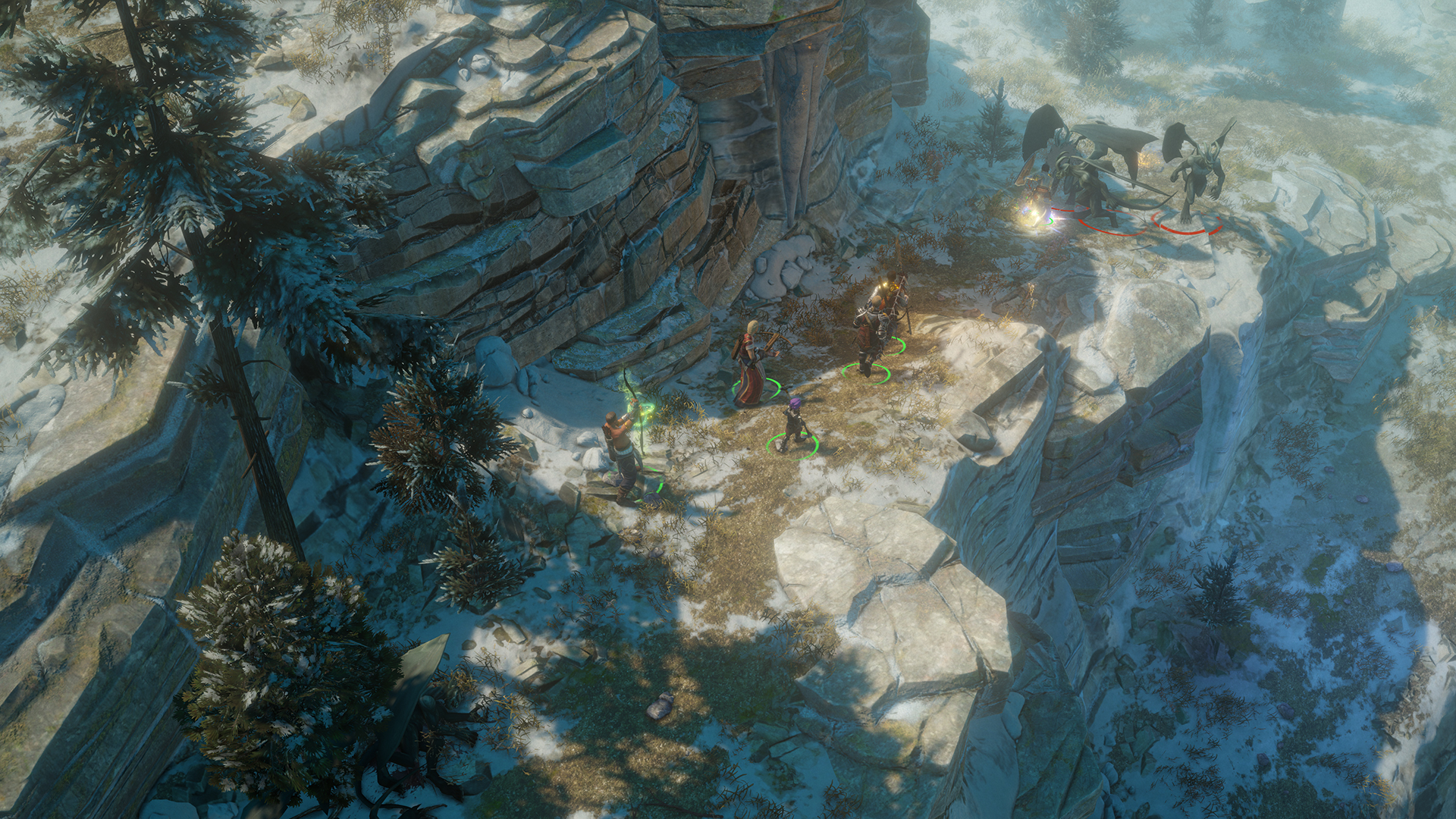
Above: Hell knights could be your fiend-loving friends.
And we really wanted our Mythics to be the key feature of the game. We wanted to tell more stories. We wanted to have more abilities and powers that are growing and reactions in the world as you become something out of legends. Because of that, we really scaled down the Crusade part. But there will still be battles, closer to old-school games like Warlords or something of that kind. A little bit more basic, but still with the same flavor.
Along the way you’ll be meeting new allies, trying to recruit them into your effort, or just pass by, or make some other decisions. Those are hell knights. The hell knights are battling the gargoyles over there. The first time you encounter them, they’re killing off the old and wounded that the paladins are protecting. It’s set them up, the hell knights, as tyrannical, structural, ruthless, efficient. It’s up to you to decide what you want to do about them. But in the long run, through the second chapter, you understand that the thing they did with the wounded — it’s not a good thing, but the gargoyles were taking the wounded to make undead out of them. The hell knights have figured out that the gargoyles are up to no good, and they were denying them resources in that way. It’s up to you to decide whether you support this, or whether you don’t agree with that and want to destroy the hell knights or otherwise do something about them.
GamesBeat: If the demons are making undead, does that mean you’re also talking about demon lords like Orcus, the Prince of the Undead, in this game? Or is it just that demons are smart and use resources?
Mishulin: It’s the second one. Of course we mention a lot of other demon lords. The leader of the gargoyles is a demon, and the gargoyles worship Kabriri, the first ghoul. Even the characters in the second chapter discuss that in the worst case scenario, another demon lord is entering the scene, but it turns out it was just a small outbreak of these types of demons. But yeah, the characters do understand the gravity of the situation. If you encounter some strange things sometimes, it’s probably a lead-up to a very powerful demon lord.
Mechanics vs. storytelling
GamesBeat: Does resting during an assault on a fortress kind of take you out of the assault?
Mishulin: Yes, but in the original adventure path, the assault takes you about several days. In the party that I was GMing, it took them about 15 days. For other parties it was longer or shorter. On the tabletop, there is a mechanic around how many crusaders you still have. It’s very difficult for the player to clear the entire map without resting. We didn’t just want to give you a few simple and boring fights. If we offer you this kind of challenge, we need to also give the opportunity to rest.
GamesBeat: As a writer, when you’re writing scenarios, do you take that into account, whether you want to break the immersion by letting the players rest?
Avellone: The expectation that you have watching this is that this is going to be a big immersive event and you’ll plow through the entire thing in like half a day of game time. But what we would do in that case, from a narrative standpoint, is we defeat that expectation. That’s a reaction the player may have, so we want to frontload — well, the siege of Drezen may take you several days, so make sure that you rest and take it in stages. We want to narratively set up a context where you don’t feel like the immediacy, where this is going to be several days of campaign. Because nothing is worse than dashed player expectations.
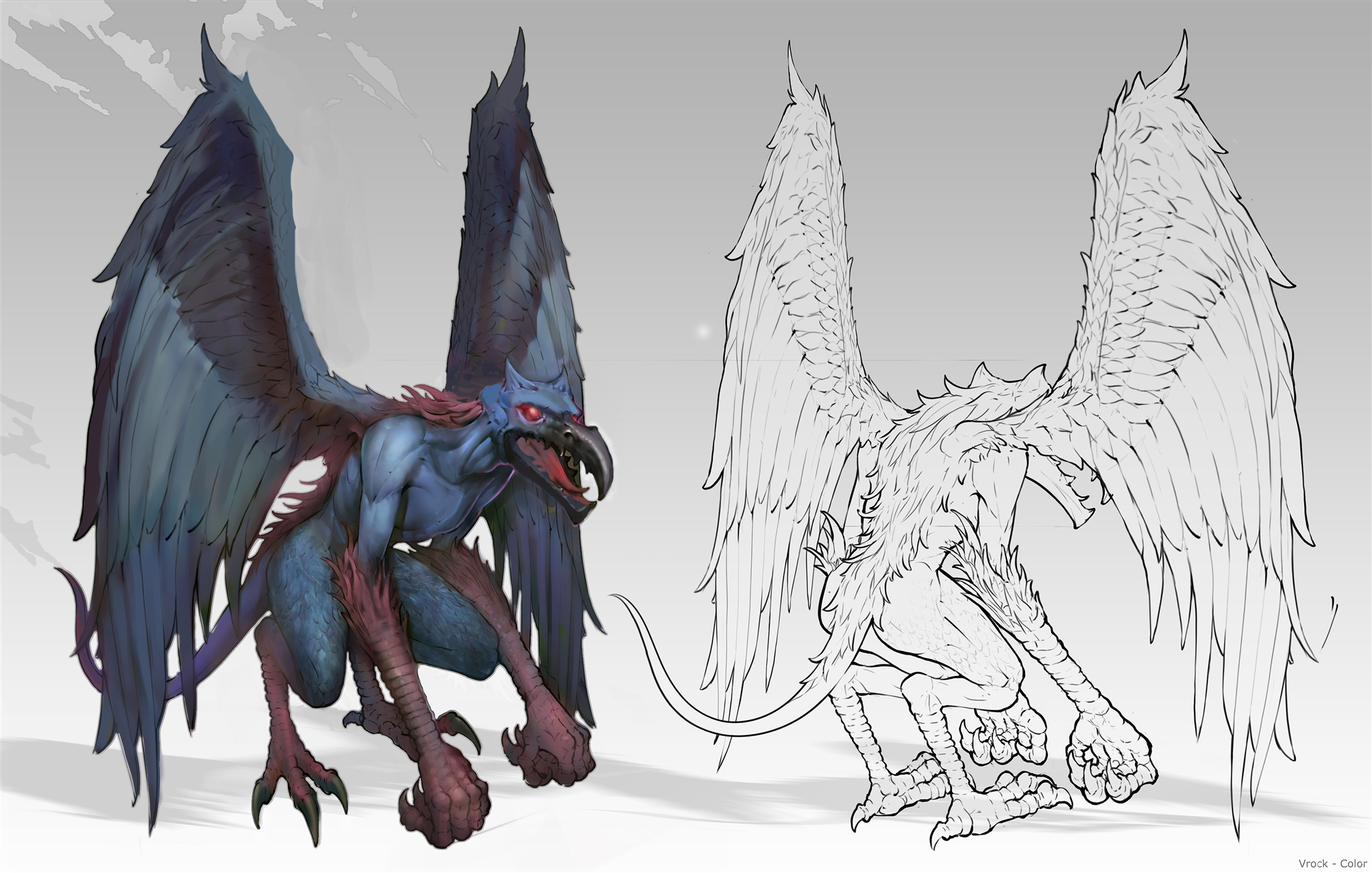
Above: The vrock is a bully, like many other demons. But it has some degree of power, too.
GamesBeat: One challenge I see with this game is, demons are scary, powerful foes. How do you make it to where players still respect their power when you’re killing them throughout the game?
Mishulin: We’re introducing different demons, and we devote special time for some of them. The first time you encounter a Vrock, it will be a miniboss, and there are also Vrocks with some dialogue. She was making sacrifices of captured crusaders to make herself the most powerful Vrock ever, but she’s kind of stupid. There are a lot of options for how to deal with her. You can just try to kill her, or you can trick her. There’s a special side stories that tricksters have with this Vrock, because they find the perfect opportunity for a lot of jokes we can pull off.
GamesBeat: Was that in the original adventure path, or did you come up with that?
Avellone: I didn’t do the Vrock encounter. That was one I heard about. It was hilarious.
Mishulin: The Vrock was initially in the book, and she’s not really smart, but she’s not really stupid. But we went after that beat and made her a bit more hilarious. We don’t want the game to be all just doom and gloom. We want it to have very different. We want you to experience different types of emotions. Some of the encounters are funny. Some of the encounters are more dark. The mythic paths themselves are very different in tone.
The crowd’s voice
GamesBeat: Is the narrative all locked in, or will anything change based on community feedback or Kickstarter goals?
Mishulin: Everything changes when we playtest things. We may have some additional input and information. Of course some of the goals in the Kickstarter that are tied to the storyline will be able to affect it. As for the second chapter, the main storyline of the second chapter, the choices and some of the consequences that are happening in the next chapter of the game, are already completed. But also some of the other types of choices, like companion stories … the beginning of the stories about the Mythic Paths, they’re not entirely in the second chapter yet. Mostly because they’re subject to change. We’re still figuring out the best way to do that.
GamesBeat: Chris, you’ve written for a number of games that have gone through crowdfunding. What is it about Kickstarter games and games that go through so much community feedback through development that attracts you?
Avellone: It removes the publisher being the sole person deciding what becomes the game narrative. Asking the players what they liked about Kickstarter and crowdsourcing in general, they feel like you’re asking the right people what kind of game. With a lot of the games, like isometric RPGs, it was almost impossible to get a publisher to fund them. They just didn’t make enough money for them. But there was a really passionate fanbase that did want to see games like that. If you’re doing a game that’s more modest in scope, versus multibillion-dollar stuff for every console and platform, being able to finance that directly, allowing them to contribute as much as they want, and seeing that happen was a huge breath of fresh air for me. It allows a wider variety of games to be made without insane budgets. If you want to have a Baldur’s Gate II experience, now we can make games like that. Asking the players to contribute on that kind of platform was the best way to get it done.
GamesBeat: Do any of the backer goals come from some of the internal tabletop campaigns you’ve ran?
Mishulin: When we started preproduction on the game, we had a huge list of things we wanted for various reasons. Enhancements in gameplay, some of the classes we wanted, some of the species we wanted. We took those and compared that to the amount of work we could put into the game, and it’s just like one-third of the list. We had to draw the line. We made our scope based on that. A lot of things and ideas were like, it would be really cool to have that, but we don’t have the opportunity right now to do so. Those are our stretch goals.
GamesBeat: Do stretch goals help you with the scope of your game, balancing the original version and what you want to do with it?
Mishulin: Yeah, they provide us with the opportunity to do so. We try to make the stretch goals so that we don’t blow the game out of proportion. We’re still trying to make those goals that allow us to release the game in a similar time frame to what we were thinking about. Maybe a couple of months later, but still on the same track. We try to provide goals that provide players more choices, more variety, more options.
GamesBeat: We’re going into a new decade. You have services like Game Pass. You have Apple Arcade. You have early access and Kickstarter and all these different models. What does that mean for RPGs going into the new decade?
Avellone: I don’t know if it changes them very much. I think Game Pass definitely has changed the consumer outlook, for sure. What’s encouraging to me is that the platform holders have said, “OK, we’re going to develop this PC RPG.” But because of things like Game Pass, there are still opportunities to do console ports like PlayStation and Xbox with Game Pass. Because those platforms need a continual influx of new games to keep people coming back to the platform, they’re more receptive. Yes, we’d love to see an Xbox version. We’d love to see a PS version. You also get that from the console publishers, because they want people coming back to the platform. That’s healthier than ever. I think Game Pass is a fantastic thing. It was pretty much inevitable that that sort of Netflix style service would be offered for games. It just works.
